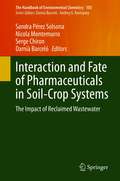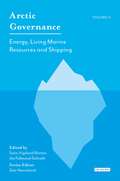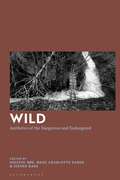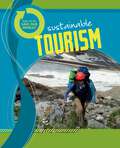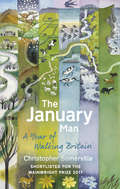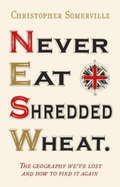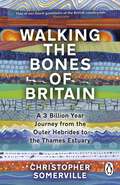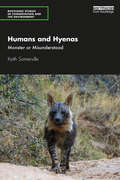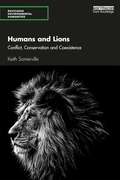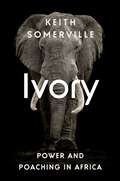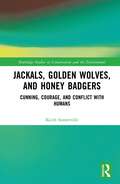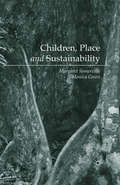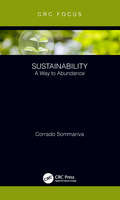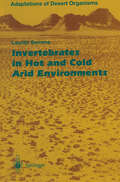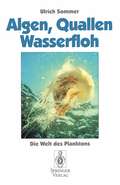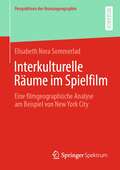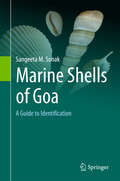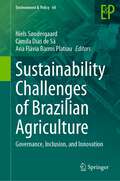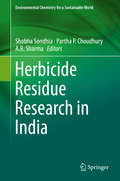- Table View
- List View
Gardening Without Irrigation: or Without Much, Anyway
by Steve SolomonHighly informative book on gardening in arid areas.
Interaction and Fate of Pharmaceuticals in Soil-Crop Systems: The Impact of Reclaimed Wastewater (The Handbook of Environmental Chemistry #103)
by Sandra Pérez Solsona Nicola Montemurro Serge Chiron Damià BarcelóThis book provides a comprehensive overview of the current knowledge on the fate and interaction of pharmaceuticals in soil-crop systems. It addresses the principles of their transport, uptake and metabolism and reviews methodologies for their analytical determination. It also discusses ecotoxicological effects arising from their presence and highlights bioremediation approaches for their removal. The use of treated wastewater to irrigate crops is becoming more widespread in regions where freshwater is limited. This practice conserves freshwater resources and contributes to nutrient recycling. However, concerns remain regarding the safety of irrigation with treated wastewater since it contains residues of pharmaceuticals that have survived treatment, which means that soil and fauna are potentially exposed to these xenobiotics. Various pathways govern the fate of pharmaceuticals in crop-soil systems, including soil degradation; formation of non-extractable residues; uptake by soil-dwelling organisms (e.g. earthworms); and uptake, transport, and metabolism in agricultural crops. Investigations into these aspects have only recently been initiated, and there is still a long way to go before a meaningful assessment of the impact of wastewater has been completed.
Arctic Governance: Energy, Living Marine Resources and Shipping (Arctic Governance Ser.)
by Ida Folkestad Soltvedt Svein Vigeland Rottem Geir HønnelandThe Polar North is known to be home to large gas and oil reserves and its position holds significant trading and military advantages, yet the maritime boundaries of the region remain ill-defined. In the twenty-first century the Arctic is undergoing profound change. As the sea ice melts, a result of accelerating climate change, global governance has become vital. In this first of three volumes, the latest research and analysis from the Fridtjof Nansen Institute, the world's leading Arctic research body, is brought together. Arctic Governance: Law and Politics investigates the legal and political order of the Polar North, focusing on governance structures and the Law of the Sea. Are the current mechanisms at work effective? Are the Arctic states' interests really clashing, or is the atmosphere of a more cooperative nature? Skilfully delineating policy in the region and analysing the consequences of treaty agreements, Arctic Governance's uncovering of a rather orderly 'Arctic race' will become an indispensable contribution to contemporary International Relations concerning the Polar North.
Wild: Aesthetics of the Dangerous and Endangered
by Solveig Bøe, Hege Charlotte Faber and Eivind KasaIn this interdisciplinary work, philosophers from different specialisms connect with the notion of the wild today and interrogate how it is mediated through the culture of the Anthropocene. They make use of empirical material like specific artworks, films and other cultural works related to the term 'wild' to consider the aesthetic experience of nature, focusing on the untamed, the boundless, the unwieldy, or the unpredictable; in other words, aspects of nature that are mediated by culture. This book maps out the wide range of ways in which we experience the wildness of nature aesthetically, relating both to immediate experience as well as to experience mediated through cultural expression. A variety of subjects are relevant in this context, including aesthetics, art history, theology, human geography, film studies, and architecture. A theme that is pursued throughout the book is the wild in connection with ecology and its experience of nature as both a constructive and destructive force.
How Can We Save Our World? Sustainable Tourism (How Can We Save Our World?)
by Andrew SolwayHow Can We Save Our World looks at how the idea of sustainable development is having an increasing influence on a wide range of human activities. The books examine the environmental costs and unsustainable nature of modern life, and discuss ways in which society can progress toward a more sustainable future.Sustainable Tourism describes the development of tourism from Roman times to the multi-million dollar industry of today. It discusses:€ The waste, over-consumption, and pollution that make tourism unsustainable€ Eco-friendly holidays that bring benefits to a region and help people learn about the importance of conservation€ Greenwashing-the abuse of ecotourism by profit-chasing businesses€ What we can do as tourists to conserve resources, benefit local people, and minimize our impact on the environment.
The January Man: A Year of Walking Britain
by Christopher Somerville'Evocatively written and charming' - CountryfileThe January Man is the story of a year of walks that was inspired by a song, Dave Goulder’s ‘The January Man’. Month by month, season by season and region by region, Christopher Somerville walks the British Isles, following routes that continually bring his father to mind. As he travels the country – from the winter floodlands of the River Severn to the lambing pastures of Nidderdale, the towering seabird cliffs on the Shetland Isle of Foula in June and the ancient oaks of Sherwood Forest in autumn – he describes the history, wildlife, landscapes and people he encounters, down back lanes and old paths, in rain and fair weather.This exquisitely written account of the British countryside not only inspires us to don our boots and explore the 140,000 miles of footpaths across the British Isles, but also illustrates how, on long-distance walks, we can come to an understanding of ourselves and our fellow walkers. Over the hills and along the byways, Christopher Somerville examines what moulded the men of his father’s generation – so reticent about their wartime experiences, so self-effacing, upright and dutiful – as he searches for ‘the man inside the man’ that his own father really was.
Never Eat Shredded Wheat: The Geography We've Lost And How To Find It Again
by Christopher SomervilleBognor Regis...Aberystwyth...Glasgow...Can you place them on a map? Most people can't these days. What kind of countryside do you pass through on your way to the Cairngorms, or the Fens, or Northumberland? What's north of the Pennines? And what's it like when you get there? Most folk wouldn't have a clue. Increasing numbers of us don't have a basic geographical notion of these islands. Blame it on a decline in formal geography teaching, or Sat-Nav and other 'A to Z and nothing in between' devices that make us lazy -- we are becoming the best travelled and least well orientated Britons ever seen. Now Christopher Somerville, bestselling author of Coast and many other books of UK exploration, presents the basics of what belongs where, which counties border one another, and what lies beyond the Watford Gap. He reminds us of the watery bits, the lumpy bits and the flat bits, and gets to grips with the smaller islands surrounding Britain -- and much more. Never Eat Shredded Wheat is a reminder of all the fascinating British geography once learned at school - geography that brings our islands vividly to life - geography which we have forgotten, or never even knew.
Walking the Bones of Britain: A 3 Billion Year Journey from the Outer Hebrides to the Thames Estuary
by Christopher Somerville'[Somerville's] infectious enthusiasm and wry humour infuse his journey from the Isle of Lewis to southern England, revealing our rich geological history with vibrant local and natural history.' - Observer'An illuminating take on the British landscape ... a remarkable achievement. ' - Tom Chesshyre'A meticulous exploration of the ground beneath our feet. Glorious.' Katherine Norbury'Somerville is a walker's writer.' Nicholas Crane'His writing is utterly enticing.' Country Walking...........................................................................................................................................................................................................Travelling a thousand miles and across three billion years, Christopher Somerville (walking correspondent of The Times and author of Coast, The January Man and Ships of Heaven) sets out to interrogate the land beneath our feet, and how it has affected every aspect of human history from farming to house construction, the Industrial Revolution to the current climate crisis.In his thousand-mile journey, Somerville follows the story of Britain's unique geology, travelling from the three billion year old rocks of the Isle of Lewis, formed when the world was still molten, down the map south eastwards across bogs, over peaks and past quarry pits to the furthest corner of Essex where new land is being formed by nature and man.Demystifying the sometimes daunting technicalities of geology with humour and a characteristic lightness of touch, Somerville's book tells a story of humanity's reckless exploitation and a lemming-like surge towards self-annihilation but also shows seeds of hope as we learn how we might work with geology to avert a climate catastrophe.It cannot fail to change the way you see the world beyond your door.
Humans and Hyenas: Monster or Misunderstood (Routledge Studies in Conservation and the Environment)
by Keith SomervilleHumans and Hyenas examines the origins and development of the relationship between the two to present an accurate and realistic picture of the hyena and its interactions with people. The hyena is one of the most maligned, misrepresented and defamed mammals. It is still, despite decades of research-led knowledge, seen as a skulking, cowardly scavenger rather than a successful hunter with complex family and communal systems. Hyenas are portrayed as sex-shifting deviants, grave robbers and attackers of children in everything from African folk tales through Greek and Roman accounts of animal life, to Disney’s The Lion King depicting hyenas with a lack of respect and disgust, despite the reality of their behaviour and social structures. Combining the personal, in-depth mining of scientific papers about the three main species and historical accounts, Keith Somerville delves into our relationship with hyenas from the earliest records from millennia ago, through the accounts by colonisers, to contemporary coexistence, where hyenas and humans are forced into ever closer proximity due to shrinking habitats and loss of prey. Are hyenas fated to retain their bad image or can their amazing ability to adapt to humans more successfully than lions and other predators lead to a shift in perspective? This book will be of great interest to students and scholars in the environmental sciences, conservation biology, and wildlife and conservation issues.
Humans and Hyenas: Monster or Misunderstood (Routledge Studies in Conservation and the Environment)
by Keith SomervilleHumans and Hyenas examines the origins and development of the relationship between the two to present an accurate and realistic picture of the hyena and its interactions with people. The hyena is one of the most maligned, misrepresented and defamed mammals. It is still, despite decades of research-led knowledge, seen as a skulking, cowardly scavenger rather than a successful hunter with complex family and communal systems. Hyenas are portrayed as sex-shifting deviants, grave robbers and attackers of children in everything from African folk tales through Greek and Roman accounts of animal life, to Disney’s The Lion King depicting hyenas with a lack of respect and disgust, despite the reality of their behaviour and social structures. Combining the personal, in-depth mining of scientific papers about the three main species and historical accounts, Keith Somerville delves into our relationship with hyenas from the earliest records from millennia ago, through the accounts by colonisers, to contemporary coexistence, where hyenas and humans are forced into ever closer proximity due to shrinking habitats and loss of prey. Are hyenas fated to retain their bad image or can their amazing ability to adapt to humans more successfully than lions and other predators lead to a shift in perspective? This book will be of great interest to students and scholars in the environmental sciences, conservation biology, and wildlife and conservation issues.
Humans and Lions: Conflict, Conservation and Coexistence (Routledge Environmental Humanities)
by Keith SomervilleThis book places lion conservation and the relationship between people and lions both in historical context and in the context of the contemporary politics of conservation in Africa. The killing of Cecil the Lion in July 2015 brought such issues to the public’s attention. Were lions threatened in the wild and what was the best form of conservation? How best can lions be saved from extinction in the wild in Africa amid rural poverty, precarious livelihoods for local communities and an expanding human population? This book traces man’s relationship with lions through history, from hominids, to the Romans, through colonial occupation and independence, to the present day. It concludes with an examination of the current crisis of conservation and the conflict between Western animal welfare concepts and sustainable development, thrown into sharp focus by the killing of Cecil the lion. Through this historical account, Keith Somerville provides a coherent, evidence-based assessment of current human-lion relations, providing context to the present situation. This book will be of interest to students and scholars of environmental and African history, wildlife conservation, environmental management and political ecology, as well as the general reader.
Humans and Lions: Conflict, Conservation and Coexistence (Routledge Environmental Humanities)
by Keith SomervilleThis book places lion conservation and the relationship between people and lions both in historical context and in the context of the contemporary politics of conservation in Africa. The killing of Cecil the Lion in July 2015 brought such issues to the public’s attention. Were lions threatened in the wild and what was the best form of conservation? How best can lions be saved from extinction in the wild in Africa amid rural poverty, precarious livelihoods for local communities and an expanding human population? This book traces man’s relationship with lions through history, from hominids, to the Romans, through colonial occupation and independence, to the present day. It concludes with an examination of the current crisis of conservation and the conflict between Western animal welfare concepts and sustainable development, thrown into sharp focus by the killing of Cecil the lion. Through this historical account, Keith Somerville provides a coherent, evidence-based assessment of current human-lion relations, providing context to the present situation. This book will be of interest to students and scholars of environmental and African history, wildlife conservation, environmental management and political ecology, as well as the general reader.
Ivory: Power and Poaching in Africa
by Keith SomervilleHalf of Tanzania's elephants have been killed for their ivory since 2007. A similar alarming story can be told of the herds in northern Mozambique and across swathes of central Africa, with forest elephants losing almost two-thirds of their numbers to the tusk trade. The huge rise in poaching and ivory smuggling in the new millennium has destroyed the hope that the 1989 ivory trade ban had capped poaching and would lead to a long-term fall in demand. But why the new upsurge? The answer is not simple. Since ancient times, large-scale killing of elephants for their tusks has been driven by demand outside Africa's elephant ranges - from the Egyptian pharaohs through Imperial Rome and industrialising Europe and North America to the new wealthy business class of China. And, who poaches and why do they do it? In recent years lurid press reports have blamed mass poaching on rebel movements and armed militias, especially Somalia's Al Shabaab, tying two together two evils - poaching and terrorism. But does this account stand up to scrutiny? This new and ground-breaking examination of the history and politics of ivory in Africa forensically examines why poaching happens in Africa and why it is corruption, crime and politics, rather than insurgency, that we should worry about.
Ivory: Power and Poaching in Africa
by Keith SomervilleHalf of Tanzania's elephants have been killed for their ivory since 2007. A similar alarming story can be told of the herds in northern Mozambique and across swathes of central Africa, with forest elephants losing almost two-thirds of their numbers to the tusk trade. The huge rise in poaching and ivory smuggling in the new millennium has destroyed the hope that the 1989 ivory trade ban had capped poaching and would lead to a long-term fall in demand. But why the new upsurge? The answer is not simple. Since ancient times, large-scale killing of elephants for their tusks has been driven by demand outside Africa's elephant ranges - from the Egyptian pharaohs through Imperial Rome and industrialising Europe and North America to the new wealthy business class of China. And, who poaches and why do they do it? In recent years lurid press reports have blamed mass poaching on rebel movements and armed militias, especially Somalia's Al Shabaab, tying two together two evils - poaching and terrorism. But does this account stand up to scrutiny? This new and ground-breaking examination of the history and politics of ivory in Africa forensically examines why poaching happens in Africa and why it is corruption, crime and politics, rather than insurgency, that we should worry about.
Jackals, Golden Wolves, and Honey Badgers: Cunning, Courage, and Conflict with Humans (Routledge Studies in Conservation and the Environment)
by Keith SomervilleThis book explores the fascinating and complex lives of the honey badger, the African jackals (black-backed and side-striped), African golden wolves, and Eurasian golden jackals. In recent years, interest in these creatures has grown exponentially, through wildlife documentaries and media clips showing the aggressive, fearless, and tenacious behaviour of the honey badger, with jackals often presented in a supporting role. Written by renowned journalist and educator Keith Somerville, this accessible volume includes historical narratives, folklore, and contemporary accounts of human–wildlife relationships and conflicts. It traces the evolution of the species; their foraging and diet; the development of their relationships with humans; and their commensal, kleptocratic, and symbiotic relationships with other carnivores, raptors and birds. It also charts the recent expansion in European jackal numbers and ranges, now including as far west as the Netherlands and as far north as Finland. Blending historical observations by non-scientists, colonial officials, administrators, and early conservationists with contemporary scientific accounts, it presents a new multidisciplinary approach that will interest researchers, scientists, and students in wildlife conservation, human–wildlife relations, zoology, biology, and environmental science.
Jackals, Golden Wolves, and Honey Badgers: Cunning, Courage, and Conflict with Humans (Routledge Studies in Conservation and the Environment)
by Keith SomervilleThis book explores the fascinating and complex lives of the honey badger, the African jackals (black-backed and side-striped), African golden wolves, and Eurasian golden jackals. In recent years, interest in these creatures has grown exponentially, through wildlife documentaries and media clips showing the aggressive, fearless, and tenacious behaviour of the honey badger, with jackals often presented in a supporting role. Written by renowned journalist and educator Keith Somerville, this accessible volume includes historical narratives, folklore, and contemporary accounts of human–wildlife relationships and conflicts. It traces the evolution of the species; their foraging and diet; the development of their relationships with humans; and their commensal, kleptocratic, and symbiotic relationships with other carnivores, raptors and birds. It also charts the recent expansion in European jackal numbers and ranges, now including as far west as the Netherlands and as far north as Finland. Blending historical observations by non-scientists, colonial officials, administrators, and early conservationists with contemporary scientific accounts, it presents a new multidisciplinary approach that will interest researchers, scientists, and students in wildlife conservation, human–wildlife relations, zoology, biology, and environmental science.
Children, Place and Sustainability
by Margaret Somerville Monica GreenThrough focusing on children's sustainability learning this book examines how school education can address the current environmental problems. It explores children's responses in literacy and language, arts-based approaches, and indigenous studies as well as scientific pedagogies to provide a unique insight into how children learn.
Sustainability: A Way to Abundance
by Corrado SommarivaThe book describes mechanisms whereby the Earth naturally thrives towards energy and resources abundance and how unsustainable industrial practices alter this trend. Introduces the concept of earth energy and associates this to the conditions of the biosphere and emphasizes the possibilities with inexpensive wind and solar energy Provides a good quantification of the concepts of sustainability and its effects on the environmentn and critical analysis and updates to the relationships between the environmental impact, affluence and technology
Sustainability: A Way to Abundance
by Corrado SommarivaThe book describes mechanisms whereby the Earth naturally thrives towards energy and resources abundance and how unsustainable industrial practices alter this trend. Introduces the concept of earth energy and associates this to the conditions of the biosphere and emphasizes the possibilities with inexpensive wind and solar energy Provides a good quantification of the concepts of sustainability and its effects on the environmentn and critical analysis and updates to the relationships between the environmental impact, affluence and technology
Invertebrates in Hot and Cold Arid Environments (Adaptations of Desert Organisms)
by Lauritz SommeA comparison of the adaptations made by invertebrates in polar deserts with those of temperate and subtropical deserts. These regions represent some of the most hostile environments on earth, demanding an array of strategies for survival. Polar species are well adapted to the cold and have to cope with arid conditions due to low precipitation and lack of liquid water during the winter. Similarly, temperate desert invertebrates have adapted to dry conditions and are also exposed to low winter temperatures. Terrestrial arthropods maintain their water-balance through behavioural and physiological adaptations. Tardigrades and nematodes are remarkable in their ability to shed all their water before entering a state of anhydrobiosis only to be revived when moisture once again becomes available.
Algen, Quallen, Wasserfloh: Die Welt des Planktons
by Ulrich SommerMilliarden winziger Krebse und Larven, Quallen und Algen, Bakterien und Pilze leben in Seen und Meeren. Das Buch führt in ihre faszinierende Formenvielfalt ein und zeigt, welche Rolle sie im Ökosystem der Gewässer spielen. Zahlreiche Beispiele, Abbildungen und Schemata verdeutlichen die komplexe Lebensgemeinschaft in dieser oft mikroskopisch kleinen Welt.
Interkulturelle Räume im Spielfilm: Eine filmgeographische Analyse am Beispiel von New York City (Perspektiven der Humangeographie)
by Elisabeth Nora SommerladSpielfilme imaginieren New York City oft als eine Stadt, in der das alltägliche Zusammenleben durch interkulturelle Begegnungen konstituiert wird. Das vorliegende Buch nimmt sich diesem Topos an. Die filmgeographische Studie analysiert, wie Spielfilme interkulturelle Begegnungen inszenieren. Die Autorin erarbeitet anhand von 17 US-amerikanischen Spielfilmen, wie interkulturelle Begegnungen strategisch inszeniert werden. Hierbei hinterfragt sie kritisch die Darstellungen gesellschaftlicher Herausforderungen, welche sich im Kontext des dargebotenen Miteinanders ergeben. Das Ergebnis sind sechs vielschichtige Dimensionen interkultureller Räume. Diese offenbaren, dass NYC letztlich vor allem als Stadt kultureller Koexistenz inszeniert wird – als Projektionsfolie einer Gesellschaft, in der sich Individuen anhand diffuser kultureller Marker beständig voneinander abgrenzen. Die Studie liefert damit einen Beitrag zum mediensensiblen Diskurs über interkulturelle Fragestellungen, denen in globalisierten, kulturell diversen und medienaffinen Gesellschaften höchste Relevanz zukommt.
Marine Shells of Goa: A Guide to Identification
by Sangeeta M. SonakThis book offers a unique introduction to the study of shells and molluscs for all those who take pleasure in shells, the treasure of the sea. However, unlike other shell albums, compendiums or guides, the central focus of this book is on shells and not molluscs. Therefore, in addition to the classification and identification of shells, the book also addresses aspects including the shell art and shell craft of Goa, the importance of shells, and literary works related to shells and their writers. The book also describes various shell habitats of Goa. The primary objective of this book is to introduce readers to the concept of shell heritage and to spark curiosity and scientific interest, not just among conchologists but also local and visiting beachgoers. Accordingly, it primarily uses straightforward, non-technical language. The book will also appeal to those readers without any previous knowledge of the subject, helping them to understand and appreciate the shells that they collect from the seashores of Goa.
Sustainability Challenges of Brazilian Agriculture: Governance, Inclusion, and Innovation (Environment & Policy #64)
by Niels Søndergaard Camila Dias de Sá Ana Flávia Barros PlatiauWith contributions from a wide range of thematic areas, this book provides a diverse perspective on the contemporary environmental challenges of Brazilian agriculture. Assessing existing experiences of governance interventions, implementation of inclusive and sustainable production practices, as well as technical innovations, this edited volume presents the reader with a nuanced perspective on sustainable future pathways for Brazilian agriculture. In many cases, actors within the agricultural sector stand in a key position to address environmental concerns, which often has generated important breakthroughs and improvement of production practices. Drawing on contributions from authors within a variety of fields, this contribution presents a trans-disciplinary perspective on the problems and pathways through which multi-level interventions can lead to sustainable solutions within the Brazilian agricultural and livestock sector. This book hereby constitutes an informed and timely contribution to the important debates about Brazil’s potential role in confronting environmental problems. More broadly, this volume also sheds light on the process of agricultural transitions in the Global South, and how food security concerns may be reconciled with sustainable production.
Herbicide Residue Research in India (Environmental Chemistry for a Sustainable World #12)
by Shobha Sondhia Partha P. Choudhury A. R. SharmaHerbicides constitute about 60% of the total pesticides consumed globally. In India, the use of herbicides started initially in tea gardens and picked up in the 1970s, when the high-yielding varieties of rice and wheat were introduced. Presently, 67 herbicides are registered in the country for controlling weeds in crops including cereals, pulses, oilseeds, fibre and tuber crops, and also in the non-crop situations. These chemicals are becoming increasingly popular because of their efficiency and relatively low cost compared with manual or mechanical weeding operations. The contribution of herbicide to total pesticide use, which was only 10-15% during the first decade of the 21st century, has now increased to about 25% with an annual growth rate of 15-20%, which is much higher than insecticides and fungicides. Though the application of herbicides is minimizing yield loss to a great extent, their residues in the food chain and surface and groundwater create some environmental nuisance particularly to non-target organisms. Research on pesticide residues in India was started during 1970s, when such chemicals were introduced on a greater scale along with high-yielding variety seeds, irrigation and chemical fertilizers for increasing food production. However, the herbicide residue research was not given much emphasis until 1990s. The Indian Council of Agricultural Research initiated a national level programme known as All India Coordinated Research Project on Weed Management through the NRC-Weed Science as the main centre along with some centers of ICAR Institutes and state agricultural universities. Over the last two decades, adequate information was generated on estimation, degradation and mitigation of herbicide residues, which were documented in annual reports, bulletins, monographs and scientific articles. However, there was no consolidated compilation of all the available information providing a critical analysis of herbicide residues. Accordingly, an effort has been made in the publication to compile the available information on herbicide residues in India. This is the first report of its kind which presents the findings of herbicide residues and their interactions in the biotic and abiotic environment. There are 16 chapters contributed by the leading herbicide residue scientists, each describing the present status of herbicide use, crops and cropping systems, monitoring, degradation and mitigation, followed by conclusions and future lines of work.This book will be useful to the weed scientists in general and herbicide residue chemists in particular, besides the policy makers, students and all those concerned with the agricultural production in the country.

